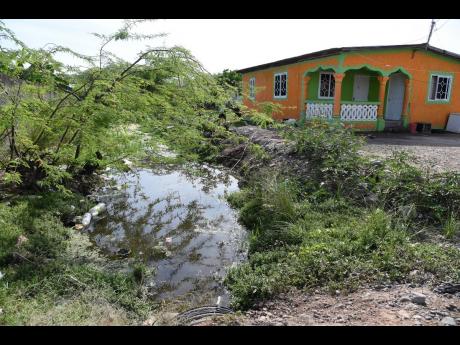Buddho calls for state help to repel mosquito attack
Residents of Buddho in Old Harbour Bay, St Catherine, have complained that they have been left to tackle the overwhelming mosquito population on their own as the island continues to reel from a dengue outbreak.
“Come one evening, when 6 o’clock come, and see if you can sit in peace. You clap til you weak,” a shopkeeper told The Gleaner as she bemoaned the mosquito crisis gripping the community.
The residents say nearby swamplands have facilitated the rise in the mosquito population and the insects have virtually been holding them hostage in their homes.
One resident joked that the mosquitoes tell them when to go inside and when they can venture outside.
“Mosquito tek we from 5:30 p.m. to 6 a.m. It wicked ‘round here, and we nuh see nobody come fi help us fight it,” one youngster said.
They were at pains to point out that they had seen neither fogging crews or vector-control workers in their space to give them a leg up in the fight. They have, however, been trying to clean the space and clear drains.
Proper drainage
“If we nuh clean up the place, nobody nuh come,” Sherona Powell told The Gleaner. “We need proper drainage.”
The residents say that with the poor drainage in the community, whenever it rains the water also settles in several areas, including in sections of the poor road surface, providing additional breeding ground for the pests.
They said that although they could not identify a confirmed dengue case in Buddho, the fact that some persons were constantly falling ill is a cause for concern.
They said that the area might have been neglected for political reasons.
“Politics at play in a everything around here, but ah we right we ah defend. When rain fall, ah trouble, and the drain dem needed,” a resident told The Gleaner.
Efforts to contact South West St Catherine Member of Parliament Everald Warmington proved futile.
However, Health and Wellness Minister Dr Christopher Tufton shared the ministry’s strategy to tackling the mosquito population with The Gleaner.
“First of all, dengue is transmitted ... in Jamaica primarily by one particular mosquito, the Aedes aegypti. That mosquito is populated throughout most of Jamaica, but in some areas more than in others. The country is mapped by the team based on the presence of the Aedes aegypti mosquito [and] the number of cases, if any, that turn up at hospitals related to dengue, and an appropriate response in proportion to that is dealt with,” the health and wellness minister said.
Tufton said that the areas are mapped where the threat is greatest.
“Otherwise, we use other mechanism, whether through mainstream media, visitation by the thousands of vector workers to speak to and encourage domestic management in terms of breeding sites, and so on. I am not suggesting that these areas don’t need fogging, and where there are complaints, we would report those and take actions, but the truth is, not all areas are treated the same because it’s based on the health risk related to a particular area,” Tufton said.
Dengue deaths
There were 20 dengue deaths confirmed, suspected or under investigation at the Bustamante Hospital for Children between January 1, 2018, and November 7 last year.
The children’s hospital racked up the highest number of fatalities among public health facilities.
St James’ Cornwall Regional Hospital was second with 15 deaths; followed by Mandeville Regional, with 11, and St Ann’s Bay Hospital, 10.
Victoria Jubilee, a maternity hospital, is the only secondary or tertiary public medical facility that has not recorded a single dengue death.
The private-owned Andrews Memorial Hospital has seen one case, and the quasi-public University Hospital of the West Indies, one.
Tufton told Parliament late last year that there were 10,559 notifications of dengue cases in Jamaica up to November 7. Of that number, 6,114 have been classified as suspected, presumed or confirmed. There have been 44 deaths.

